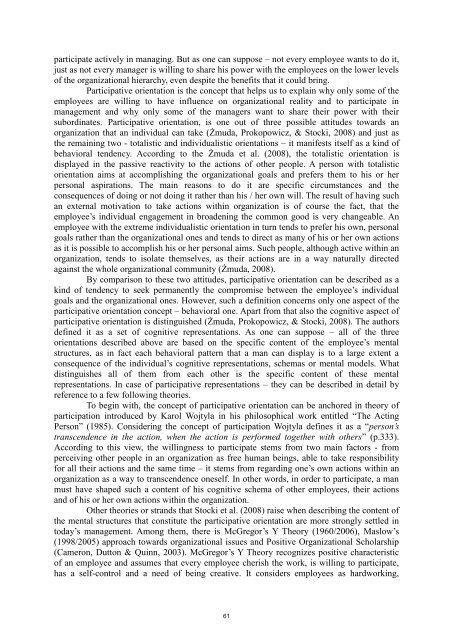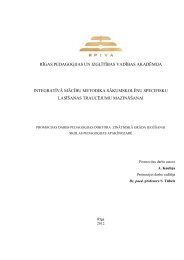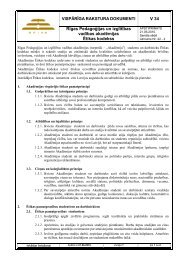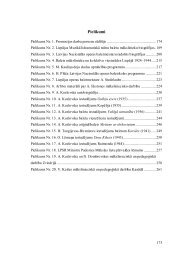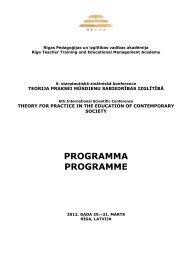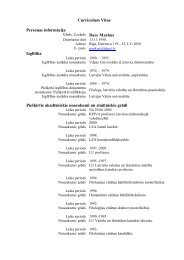saturs - rpiva
saturs - rpiva
saturs - rpiva
- No tags were found...
Create successful ePaper yourself
Turn your PDF publications into a flip-book with our unique Google optimized e-Paper software.
participate actively in managing. But as one can suppose – not every employee wants to do it,<br />
just as not every manager is willing to share his power with the employees on the lower levels<br />
of the organizational hierarchy, even despite the benefits that it could bring.<br />
Participative orientation is the concept that helps us to explain why only some of the<br />
employees are willing to have influence on organizational reality and to participate in<br />
management and why only some of the managers want to share their power with their<br />
subordinates. Participative orientation, is one out of three possible attitudes towards an<br />
organization that an individual can take (Żmuda, Prokopowicz, & Stocki, 2008) and just as<br />
the remaining two - totalistic and individualistic orientations – it manifests itself as a kind of<br />
behavioral tendency. According to the Żmuda et al. (2008), the totalistic orientation is<br />
displayed in the passive reactivity to the actions of other people. A person with totalistic<br />
orientation aims at accomplishing the organizational goals and prefers them to his or her<br />
personal aspirations. The main reasons to do it are specific circumstances and the<br />
consequences of doing or not doing it rather than his / her own will. The result of having such<br />
an external motivation to take actions within organization is of course the fact, that the<br />
employee’s individual engagement in broadening the common good is very changeable. An<br />
employee with the extreme individualistic orientation in turn tends to prefer his own, personal<br />
goals rather than the organizational ones and tends to direct as many of his or her own actions<br />
as it is possible to accomplish his or her personal aims. Such people, although active within an<br />
organization, tends to isolate themselves, as their actions are in a way naturally directed<br />
against the whole organizational community (Żmuda, 2008).<br />
By comparison to these two attitudes, participative orientation can be described as a<br />
kind of tendency to seek permanently the compromise between the employee’s individual<br />
goals and the organizational ones. However, such a definition concerns only one aspect of the<br />
participative orientation concept – behavioral one. Apart from that also the cognitive aspect of<br />
participative orientation is distinguished (Żmuda, Prokopowicz, & Stocki, 2008). The authors<br />
defined it as a set of cognitive representations. As one can suppose – all of the three<br />
orientations described above are based on the specific content of the employee’s mental<br />
structures, as in fact each behavioral pattern that a man can display is to a large extent a<br />
consequence of the individual’s cognitive representations, schemas or mental models. What<br />
distinguishes all of them from each other is the specific content of these mental<br />
representations. In case of participative representations – they can be described in detail by<br />
reference to a few following theories.<br />
To begin with, the concept of participative orientation can be anchored in theory of<br />
participation introduced by Karol Wojtyla in his philosophical work entitled “The Acting<br />
Person” (1985). Considering the concept of participation Wojtyla defines it as a “person’s<br />
transcendence in the action, when the action is performed together with others” (p.333).<br />
According to this view, the willingness to participate stems from two main factors - from<br />
perceiving other people in an organization as free human beings, able to take responsibility<br />
for all their actions and the same time – it stems from regarding one’s own actions within an<br />
organization as a way to transcendence oneself. In other words, in order to participate, a man<br />
must have shaped such a content of his cognitive schema of other employees, their actions<br />
and of his or her own actions within the organization.<br />
Other theories or strands that Stocki et al. (2008) raise when describing the content of<br />
the mental structures that constitute the participative orientation are more strongly settled in<br />
today’s management. Among them, there is McGregor’s Y Theory (1960/2006), Maslow’s<br />
(1998/2005) approach towards organizational issues and Positive Organizational Scholarship<br />
(Cameron, Dutton & Quinn, 2003). McGregor’s Y Theory recognizes positive characteristic<br />
of an employee and assumes that every employee cherish the work, is willing to participate,<br />
has a self-control and a need of being creative. It considers employees as hardworking,<br />
61


